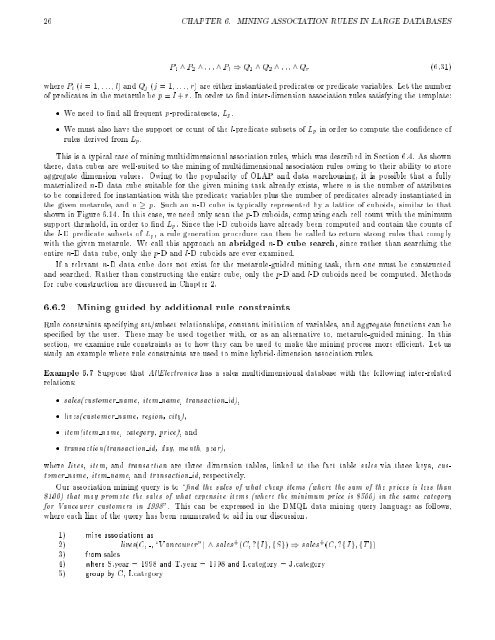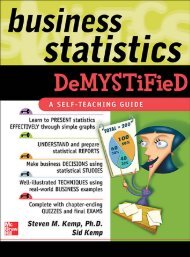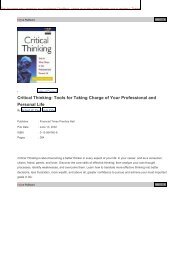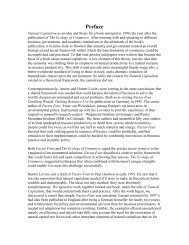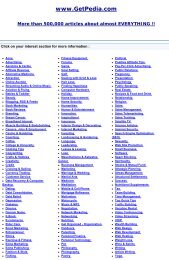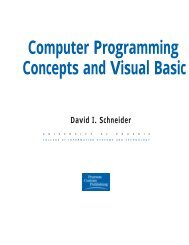Chapter 06 - Changing Education Paradigm
Chapter 06 - Changing Education Paradigm
Chapter 06 - Changing Education Paradigm
You also want an ePaper? Increase the reach of your titles
YUMPU automatically turns print PDFs into web optimized ePapers that Google loves.
26 CHAPTER 6. MINING ASSOCIATION RULES IN LARGE DATABASES<br />
P1 ^ P2 ^ :::^Pl )Q1^Q2^:::^Qr<br />
(6.31)<br />
where Pi (i =1;:::;l) and Qj (j =1;:::;r) are either instantiated predicates or predicate variables. Let the number<br />
of predicates in the metarule be p = l + r. In order to nd inter-dimension association rules satisfying the template:<br />
We need to nd all frequent p-predicatesets, Lp.<br />
We must also have the support or count of the l-predicate subsets of Lp in order to compute the con dence of<br />
rules derived from Lp.<br />
This is a typical case of mining multidimensional association rules, which was described in Section 6.4. As shown<br />
there, data cubes are well-suited to the mining of multidimensional association rules owing to their ability to store<br />
aggregate dimension values. Owing to the popularity of OLAP and data warehousing, it is possible that a fully<br />
materialized n-D data cube suitable for the given mining task already exists, where n is the number of attributes<br />
to be considered for instantiation with the predicate variables plus the number of predicates already instantiated in<br />
the given metarule, and n p. Such ann-D cube is typically represented by a lattice of cuboids, similar to that<br />
shown in Figure 6.14. In this case, we need only scan the p-D cuboids, comparing each cell count with the minimum<br />
support threshold, in order to nd Lp. Since the l-D cuboids have already been computed and contain the counts of<br />
the l-D predicate subsets of Lp, a rule generation procedure can then be called to return strong rules that comply<br />
with the given metarule. We call this approach anabridged n-D cube search, since rather than searching the<br />
entire n-D data cube, only the p-D and l-D cuboids are ever examined.<br />
If a relevant n-D data cube does not exist for the metarule-guided mining task, then one must be constructed<br />
and searched. Rather than constructing the entire cube, only the p-D and l-D cuboids need be computed. Methods<br />
for cube construction are discussed in <strong>Chapter</strong> 2.<br />
6.6.2 Mining guided by additional rule constraints<br />
Rule constraints specifying set/subset relationships, constant initiation of variables, and aggregate functions can be<br />
speci ed by the user. These may be used together with, or as an alternative to, metarule-guided mining. In this<br />
section, we examine rule constraints as to how they can be used to make the mining process more e cient. Let us<br />
study an example where rule constraints are used to mine hybrid-dimension association rules.<br />
Example 6.7 Suppose that AllElectronics has a sales multidimensional database with the following inter-related<br />
relations:<br />
sales(customer name, item name, transaction id),<br />
lives(customer name, region, city),<br />
item(item name, category, price), and<br />
transaction(transaction id, day, month, year),<br />
where lives, item, and transaction are three dimension tables, linked to the fact table sales via three keys, customer<br />
name, item name, and transaction id, respectively.<br />
Our association mining query is to \ nd the sales of what cheap items (where the sum of the prices is less than<br />
$100) that may promote the sales of what expensive items (where the minimum price is$500) in the same category<br />
for Vancouver customers in 1998". This can be expressed in the DMQL data mining query language as follows,<br />
where each line of the query has been enumerated to aid in our discussion.<br />
1) mine associations as<br />
2) lives(C; ; \V ancouver") ^ sales + (C; ?fIg; fSg) ) sales + (C; ?fJg; fTg)<br />
3) from sales<br />
4) where S.year = 1998 and T.year = 1998 and I.category = J.category<br />
5) group by C, I.category


